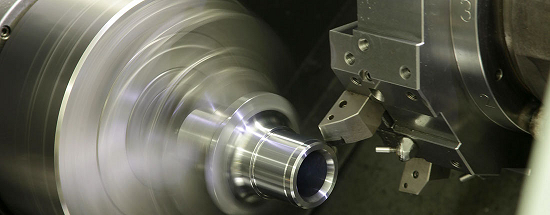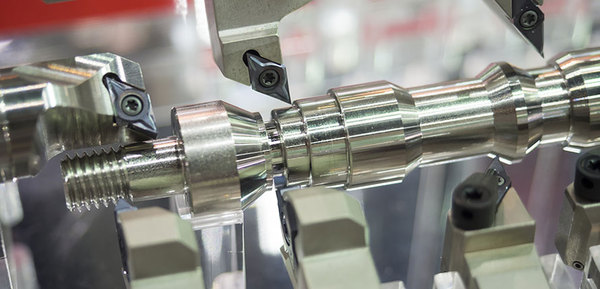Skills and experience of CNC lathe machining
It has been ten years since I operated the CNC lathe in a blink of an eye, and I have accumulated some processing skills and experience of the CNC lathe, and I will communicate with my colleagues. Due to the frequent replacement of processed parts and limited factory conditions, we have been programming ourselves for the past ten years, setting the tool ourselves, debugging and completing the processing of the parts, and summing up the operation skills into the following points.
1. Programming skills of CNC lather machining
Because our factory has higher requirements for the accuracy of processed products, the items to be considered when programming are as below
1). Processing sequence of parts
Drill first and then flat end (this is to prevent shrinkage when drilling);
Roughing first, then finishing (this is to ensure parts accuracy);
The first processing tolerance is large and the last processing tolerance is small (this is to ensure that the surface of the small tolerance size is not scratched and prevent parts from deforming).
2). Choose a reasonable speed, feed rate and cutting depth according to the material hardness
a) Choose high speed, high feed rate and large cutting depth for carbon steel materials. For example: 1Gr11, choose S1600, F0.2, cutting depth 2mm;
b) Carbide selects low speed, low feed rate and small cutting depth. For example: GH4033, choose S800, F0.08, cutting depth 0.5mm;
c) Choose low speed, high feed rate and small cutting depth for titanium alloy. For example: Ti6, select S400, F0.2, and cut depth 0.3mm. Take the processing of a part as an example: the material is K414, which is a special hard material. After many tests, the final selection is S360, F0.1, and the cutting depth is 0.2. Only qualified parts are processed.

2. Tool setting skills of CNC lathe machining
Tool setting is divided into tool setting instrument tool setting and direct tool setting. Most of the lathes in our factory do not have a tool setting instrument, which is direct tool setting. The tool setting technique mentioned below is direct tool setting.
First select the center of the right end of the part as the tool setting point and set it as the zero point. After the machine tool returns to the origin, each tool that needs to be used is set to the center of the right end of the part as the zero point; the tool touches the right end and enters Z0 to click to measure. The measured value will be automatically recorded in the tool compensation value of the tool, which means that the Z axis tool setting is correct, the X tool setting is a trial cutting tool setting, and the outer circle of the tool turning part is less, and the measured outer circle value is measured ( If x is 20mm) input x20, click measure, the tool compensation value will automatically record the measured value, then the x-axis is also right; this tool setting method, even if the machine is powered off, the call will not change after the call is restarted The tool value can be applied to the mass production of the same part for a long time without shutting the lathe without recalibrating the tool.
3. Debugging skills of CNC lathe machining
After programming the parts, you need to carry out trial cutting and debugging after the tool is set. In order to prevent errors in the program and errors in the tool setting, which will cause a collision accident, we should first perform an empty stroke simulation processing, in the coordinate system of the machine tool. The tool is translated to the right by 2 to 3 times the total length of the part; then the simulation process is started. After the simulation process is completed, the program and the tool are confirmed to be correct, and then the part is processed. After the first part is processed, it is self-checked to confirm the pass , And then find a full-time inspection and inspection, only after the full-time inspection confirms that it is qualified, it means that the debugging is over.

4. Complete parts processing of CNC lathe machining
After the trial cut of the first piece is completed, batch production is required, but the qualification of the first piece does not mean that the entire batch of parts will be qualified, because in the processing process, the tool will be worn due to the difference in the processing material. Soft, the tool wear is small, the processing material is hard, and the tool wear is fast, so in the process of processing, it is necessary to diligently check, increase and decrease the tool compensation value in time to ensure the qualification of the parts.
Taking a part as an example, the processing material is K414, and the total processing length is 180mm. Due to the extremely hard material, the tool wears very quickly during processing. From the start to the end, the tool wear will produce a slight 10-20mm, so we must In the program, artificially add a degree of 10-20mm, so as to ensure the qualification of the parts.
In short, the basic principle of processing: first roughing, removing the excess material of the workpiece, and then finishing; the vibration should be avoided during processing; the thermal denaturation of the workpiece during processing should be avoided, and there are many reasons for the vibration, which may be overloaded Large; it may be the resonance of the machine tool and the workpiece, or it may be the lack of rigidity of the machine tool, or it may be caused by the passivation of the tool. We can reduce the vibration by the following methods; reduce the infeed and the machining depth, check Whether the workpiece is clamped securely, increase the speed of the tool. The latter reduces the speed to reduce resonance. In addition, check whether it is necessary to replace the new tool.
5. Experiences in preventing collisions of machine tools
The impact of machine tool collision is a great damage to the accuracy of the machine tool, and it has different effects on different types of machine tools. Generally speaking, it has a greater impact on machine tools with less rigidity. Therefore, for high-precision CNC lathes, collisions must be eliminated. As long as the operator is careful and masters certain anti-collision methods, collisions can be completely prevented and avoided.
The main reasons for collisions are: First, the diameter and length of the tool are entered incorrectly; Second, the size of the workpiece and other related geometric dimensions are entered incorrectly, and the initial position of the workpiece is incorrect; Third, the workpiece coordinate system of the machine tool is set incorrectly Or, the zero point of the machine tool is reset during the machining process, and changes occur. Most of the machine tool collisions occur during the rapid movement of the machine tool. The collisions at this time are also the most harmful and should be absolutely avoided. Therefore, the operator should pay special attention to the initial stage of the execution of the program and when the machine tool is changing the tool. At this time, once the program is edited incorrectly, and the diameter and length of the tool are entered incorrectly, then collision is easy to occur. At the end of the program, if the sequence of CNC axis retraction is wrong, then collision may also occur.
In order to avoid the above-mentioned collision, the operator must give full play to the functions of the five senses when operating the machine tool, and observe whether the machine tool has abnormal movements, sparks, noise and abnormal noise, vibration, or burnt smell. If an abnormal situation is found, the program should be stopped immediately, and the machine tool can continue to work only after the standby bed problem is resolved.
In short, mastering the operation skills of CNC machine tools is a gradual process and cannot be accomplished at one stroke. It is based on mastering the basic operation of machine tools, basic machining knowledge and basic programming knowledge. CNC machine tool operation skills are not static, it is an organic combination that requires the operator to give full play to their imagination and hands-on ability, and is an innovative labor.


